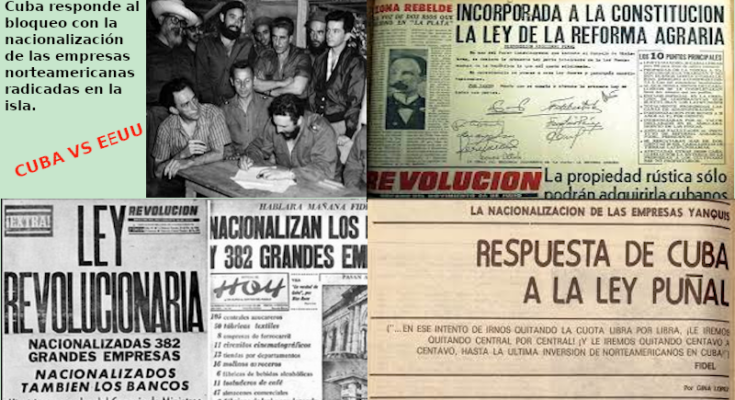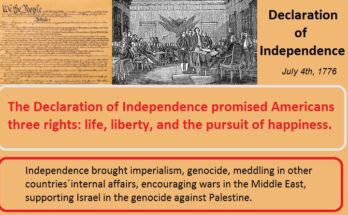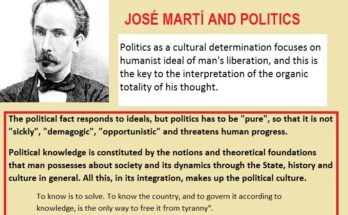The diplomatic and economic war (economic blockade) unleashed by the government of the United States against Cuba became official when the Embassy of the United States of America in Havana issued a Diplomatic Note on October 21, 1960, loaded with hypocrisy in its greetings and malice in its content, stating that the Embassy of the United States of America had received various reports that the flag of the United States had been painted on the fuselage of five or six airplanes at the San Antonio de los Baños air base. Finally it meant that there were no U.S. aircraft at that base and no aircraft were authorized to display the U.S. flag as part of their insignia.
After learning of the contents of the insolent U.S. Note, on October 22, 1960, Dr. Carlos Olivares, in his capacity as Acting Minister of Foreign Affairs, wrote a strong letter of protest to Ambassador Phillip Bonsal:
Fabrication to justify the economic blockade
“With regard to Note number 420 of your Embassy, and in the name of the Revolutionary Government, I find myself in the unavoidable duty of signifying our most energetic repudiation and indignant rejection of everything expressed therein; from the respect hypocritically offered in its opening lines, to the ostensibly unscrupulous disrespectfulness with which it seeks to legitimize, albeit with the pointing out in this case of absolutely and totally false facts, the criminal action of espionage, by referring to ‘reports’ that this Embassy claims to have obtained from a Cuban military base.
“The entire content of the Note is malevolent and false, and this is perfectly clear to Your Excellency […] if some of the contents of the Note were to be analyzed [… …] if we were to analyze some of the specific circumstances surrounding the subtle appearance of that Note, such as its impersonal character, and its form of revision, intermingled among other routine documents, we must agree that the purpose of intention pursued was really and effectively other, that is, to inadvertently achieve its entry into our Chancellery as if it were a matter of no importance, for the purpose of surely achieving, with the weight of our silence, an element of proof for some conceived monstrosity: Perhaps, pretending to demonstrate on the occasion of its consummation, that the armed invasion prepared by your Government, as you are aware, against our Country was only the product of the action of national groups without nexus or linkage to the powers of your Empire, that when Cuba and its friends all over the world shout their denunciation against American imperialism for the realization of such events, they resort to the infamous text of the Note we condemn to argue that those U.S. planes – real Yankees, with real U.S. flags – which are ready for the aggressive flight in the Republic of Guatemala and off the coasts of Florida were not such, but Cuban planes painted by us here, to damage ‘the reputation of the Empire’ and to accuse it ‘unjustly’ of directing, financing and co-participating in the military aggression?
Perhaps note 420 has something to do with the plan of self-aggression at the Caimanera Naval Base, so clearly and distinctly denounced by the Prime Minister of our Revolutionary Government, Commander Fidel Castro Ruz”.
Blockade against independentism
In the debate held on Saturday, October 22, between Richard Nixon, then Vice President of the United States and candidate for the presidency, and John F. Kennedy, the Democratic Party candidate for the presidency of the United States, he admitted that the US government intended to repeat in Cuba the “Operation Guatemala” which, in 1954, provoked the overthrow of President Jacobo Arbenz. In addition, Nixon expressed his solidarity with the embargo which he called “quarantining Castro economically”; in the same way that withdrawing the U.S. Ambassador to Cuba he considered “quarantining him diplomatically”. Finally, he reasoned that the strategy would produce an uprising against the Cuban government “as we did in Guatemala”.
A response to the US blockade
Faced with the imperialist aggression, on the night of October 24, the highest leadership of the Revolutionary Government, in accordance with the faculties granted to it by Law 851 for the Defense of the National Economy signed on July 6, 1960, and applied for the first time on August 6, subscribed Resolution No. 3 which ordered the nationalization of 166 enterprises belonging to US persons or firms.
This new revolutionary measure corresponded to the need to respond to the aggressive Yankee disposition of a general blockade of US exports to Cuba, aimed at strangling the Cuban economy. In one of its parts Resolution No. 3 stated:
“As the Revolutionary Government has the duty to defend that economy, and in addition, it is fundamental for the liberation and economic development of our country the liquidation of the American commercial or industrial enterprises that at present constitute in our Homeland the residue of the financial capital of that country, it has ordered the nationalization, by means of forced expropriation, of all the assets of those 166 companies, among which are Ten Cents, Sears, Burrus Flour Mill, Mcfarlane Foundry, Firestone, Goodrich, Canada Dry, Coca Cola, Minimax, Ekloh, Abbot, Squibb, Hershey Railroad, insurance and mining companies, distributors of machinery, cars and accessories, tobacco companies, hotels and casinos.
Warning if blockade implement
In this way, the words of the leader of the Revolution pronounced nine days earlier, on October 15, 1960, were fulfilled: “If economic aggression follow us, we will continue nationalizing American companies, in accordance with that legislation”.
From those moments on the US government has tried to wipe out the Cuban Revolution through unilateral sanctions and tightening the economic and financial blockade, reaching its top degree with Trump administration.
Related article
Nationalization against blockade I
Fighting the US blockade on Cuba




